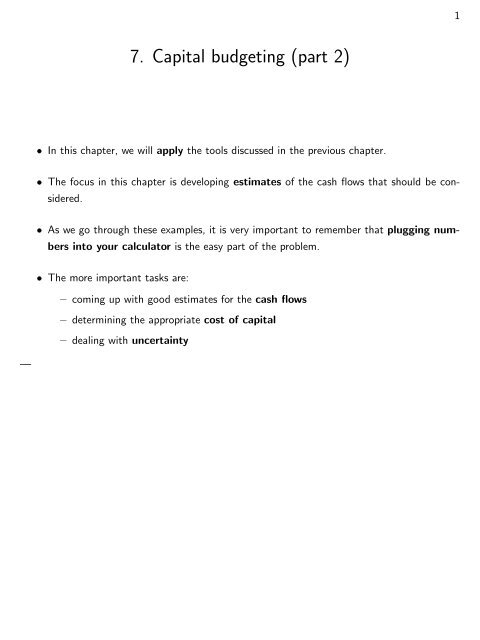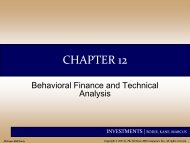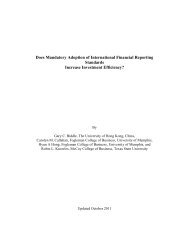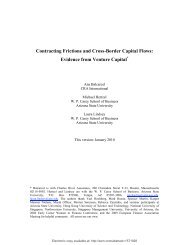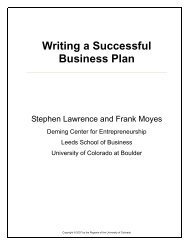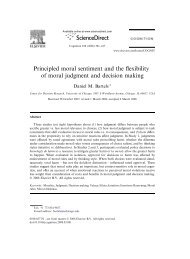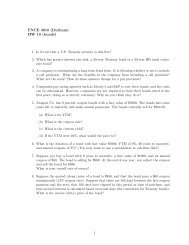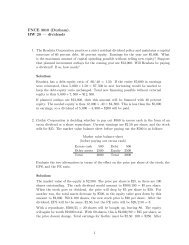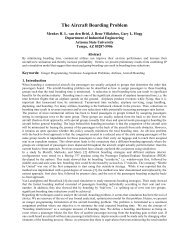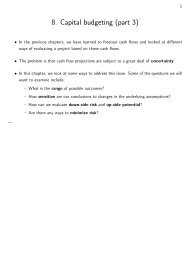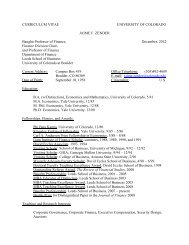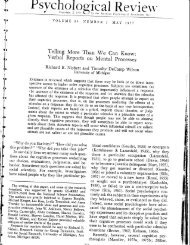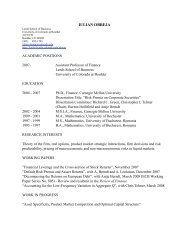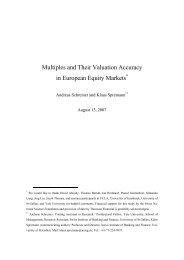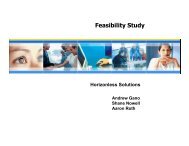7. Capital budgeting (part 2)
7. Capital budgeting (part 2)
7. Capital budgeting (part 2)
You also want an ePaper? Increase the reach of your titles
YUMPU automatically turns print PDFs into web optimized ePapers that Google loves.
1<br />
<strong>7.</strong> <strong>Capital</strong> <strong>budgeting</strong> (<strong>part</strong> 2)<br />
• In this chapter, we will apply the tools discussed in the previous chapter.<br />
• The focus in this chapter is developing estimates of the cash flows that should be considered.<br />
• As we go through these examples, it is very important to remember that plugging numbers<br />
into your calculator is the easy <strong>part</strong> of the problem.<br />
• The more important tasks are:<br />
– coming up with good estimates for the cash flows<br />
– determining the appropriate cost of capital<br />
– dealing with uncertainty<br />
—
Introduction<br />
2<br />
We begin with a quick review of what costs to include in the capital <strong>budgeting</strong> analysis....<br />
—
Stand-alone principle<br />
3<br />
• We will typically analyze each project as a stand-alone entity.<br />
• Cash-flows for the rest of the firm that are unaffected by the adoption of the project can<br />
be ignored.<br />
—
Incremental cash flows<br />
4<br />
• We only need to think about changes in cash flows associated with adopting the project.<br />
• Cash-flows that are not affected if the project is adopted can be ignored.<br />
—
Sunk costs<br />
5<br />
• Costs that have already been incurred and do not depend on whether the project is accepted<br />
are referred to as sunk costs.<br />
• Sunk costs should be excluded from the analysis.<br />
Example: A consultant is hired to help evaluate whether a new project should be accepted. the<br />
cost of hiring the consultant is a sunk cost. This money is gone whether or not the project is<br />
adopted.<br />
—
Opportunity costs<br />
6<br />
• If the project is accepted, some resources already available to the firm may be used (and<br />
thus unavailable for other uses).<br />
• The incremental cash flows resulting from these resources not being available for other<br />
projects are referred to as opportunity costs.<br />
• Opportunity costs should be included in the analysis.<br />
Example: If I already own a piece of land and am thinking about building a McDonalds on it,<br />
I should include the market value of the land as a cost of the project. I could sell the land if I<br />
decide not to build the restaurant.<br />
—
Side effects<br />
7<br />
• Adoption of a project may cause indirect changes in cash flows. Such changes are referred<br />
to as (side effects).<br />
• Side effects should be included in the analysis.<br />
Examples:<br />
• Introduction of a new product may siphon sales off of existing similar products (erosion).<br />
– Example: When McDonald’s introduced the Arch Deluxe sandwich, instead of generating<br />
new sales, it primarily reduced sales of Big MAcs and Quarter Pounders.<br />
• A new product may also increase sales of related products.<br />
– Example: When HP is thinking of introducing a new line of printers, what kind of<br />
side effects do you think they might be thinking about<br />
—
Changes in NWC<br />
8<br />
• Adoption of the project may require a change in net working capital.<br />
– Additional cash may be needed to pay expenses<br />
– Investment in inventory and accounts payable may also be needed.<br />
• Some of the financing may come from accounts receivable (payments due to suppliers),<br />
but the firm will need to supply the balance.<br />
• Changes in NWC requirements due to adoption of project should be included in the<br />
analysis.<br />
—
Financing costs<br />
9<br />
Financing costs (e.g., interest) are not included in the analysis.<br />
• Interest is included as <strong>part</strong> of cash flow to creditors, not cash flow from assets.<br />
• More generally, we do not want to consider at this point the <strong>part</strong>icular mixture of debt vs<br />
equity a firm actually uses to finance the project. This is an important but separate issue<br />
(discussed later).<br />
—
Taxes<br />
10<br />
We are always interested in after-tax cash flows.<br />
• In <strong>part</strong>icular, we need to account for the tax deduction due to depreciation.<br />
—<br />
• We will also need to account for tax implications from the salvage value of the project<br />
when it is ended.
Example<br />
11<br />
We would like to assess the value of a project that involves the manufacture and sale of a new<br />
variety of breakfast cereal..<br />
• We believe we can sell 30,000 boxes per year at $3 per box.<br />
• The product has a three-year life span.<br />
• Variable costs are $1.50 per box.<br />
• Fixed costs are $45,000 initial investment plus $7,000 per year<br />
• Depreciate the initial investment to zero over three years (straight-line).<br />
• Suppose that the salvage value of the equipment is zero.<br />
• The project requires an initial $10,000 investment in working capital.<br />
• Tax rate is 34%.<br />
—<br />
• Discount rate = 20%.
Example — continued<br />
12<br />
First, we need to compute some cash flows. Recall:<br />
Project cash flow =<br />
Project operating cash flow<br />
− Project change in net working capital<br />
− Project capital spending<br />
Operating cash flow =<br />
EBIT + Depreciation - Taxes<br />
= NI + Interest + Depreciation<br />
—
Example — continued<br />
13<br />
0 1 2 3<br />
OCF 30180 30180 30180<br />
ChNWC -10000 0 0 10000<br />
NCS -45000 0 0 0<br />
========================================================<br />
CFFA -55000 30180 30180 40180<br />
NPV (R=20%) $14,360.65<br />
IRR 35.32%<br />
PI (R=20%) 1.26<br />
Notes:<br />
• Depr = 45000 / 3 = 15000<br />
• EBIT = Sales - costs - depr = 30000 x (3 - 1.5) - 7000 - 15000 = 23000<br />
• NI = EBIT x (1 - T) = 23000 x .66 = 15180<br />
Remember: we ignore interest expense!<br />
• OCF = NI + Depr = 15180 + 15000 = 30180<br />
• NWC is recovered at end of project.<br />
• Be careful about signs for ChNWC and NCS!!<br />
—
Depreciation<br />
14<br />
• Recall that depreciation is a non-cash expense. The only effect on cash flows is through<br />
taxes.<br />
• Thus, tax law is the usual basis for computing depreciation when making capital investment<br />
decisions.<br />
—
MACRS<br />
15<br />
Modified accelerated cost recovery system (MACRS) was enacted by the Tax Reform Act<br />
of 1986.<br />
• Each asset is assigned to a <strong>part</strong>icular class.<br />
• The class determines the depreciation schedule.<br />
—<br />
• Each year’s depreciation is computed by multiplying the item’s initial cost value by some<br />
fixed percentage (determined by the class).
MACRS (continued)<br />
16<br />
Class<br />
3-year<br />
5-year<br />
7-year<br />
Examples<br />
Equipment used in research<br />
Autos, computers<br />
Most industrial equipment<br />
Depreciation schedules<br />
Year 3-year 5-year 7-year<br />
1 33.33% 20.00% 14.29%<br />
2 44.44 32.00 24.49<br />
3 14.82 19.20 1<strong>7.</strong>49<br />
4 <strong>7.</strong>41 11.52 12.49<br />
5 11.52 8.93<br />
6 5.76 8.93<br />
7 8.93<br />
8 4.45<br />
(Note that the percentages add up to 100 in each column.)<br />
—
MACRS — continued<br />
17<br />
Non-residential real property (e.g., office buildings) is depreciated over 31.5 years using<br />
straight line method.<br />
Residential property is depreciated over 2<strong>7.</strong>5 years using straight-line method.<br />
—
Salvage value and clean-up costs<br />
18<br />
• If an item is sold, taxes must be paid on the difference between its sale price and its book<br />
value.<br />
• If the book value exceeds the market value, then the difference is treated as a loss for tax<br />
purposes.<br />
• If there are any clean-up costs, these are tax deductible.<br />
—
Salvage value — continued<br />
19<br />
AT SV = After-tax salvage value<br />
BT SV = Before-tax salvage value<br />
CUC = Clean-up costs<br />
BV = Book value at time of sale<br />
AT SV = BT SV + T × (BV − BT SV )<br />
= (1 − T ) × BT SV + T × BV<br />
If BV=0, this is<br />
AT SV = (1 − T ) × BT SV<br />
If there are also clean-up costs,<br />
AT SV = (1 − T ) × (BT SV − CUC) + T × BV<br />
—
Example<br />
20<br />
The Gator Shoe Company is looking at investing in some equipment to produce a new line of shoes.<br />
The equipment will be used for three years then sold. Evaluate the project over a three-year horizon<br />
based on the following information:<br />
• Projected sales are as follows:<br />
Year Unit sales<br />
1 10000<br />
2 5000<br />
3 2000<br />
• The shoes will sell for $30/pair the first year and for $25 per year thereafter.<br />
• Production costs are: $100,000 initial investment, fixed costs of $5,000 per year, and variable<br />
costs of $8 per item the first year, $7 per item the second year, and $6 per item the third year.<br />
• The manufacturing equipment will be depreciated using the 3-year MACRS schedule. The salvage<br />
value will be $5,000 at the end of three years.<br />
• Initial NWC will be $8000. At the end of each year NWC will be 15% of that year’s sales.<br />
• The tax rate is 34% and the appropriate discount rate is 15%.<br />
—
Example — continued<br />
21<br />
Recall the following definitions. These are the things we will need to compute.<br />
Project cash flow =<br />
Project operating cash flow<br />
− Project change in net working capital<br />
− Project capital spending<br />
Operating cash flow =<br />
EBIT + Depreciation − Taxes<br />
—
Depreciation and salvage value<br />
22<br />
0 1 2 3<br />
DeprSched 0 0.33 0.44 0.15<br />
Depr 0 33330 44440 14820<br />
FA 100000 66670 22230 7410<br />
BTSV = 5000<br />
EndBV = 7410<br />
ATSV = 5819.4<br />
Note: ATSV = BTSV x (1-T) + EndBV x T<br />
—
OCF<br />
23<br />
0 1 2 3<br />
Sales 300000 125000 50000<br />
Costs 85000 40000 17000<br />
Depr 0 33330 44440 14820<br />
-------------------------------------------------------<br />
NI 0 119902.2 26769.6 11998.8<br />
OCF 0 153232.2 71209.6 26818.8<br />
Notes:<br />
• NI = (sales - costs - depr) x (1-t)<br />
• OCF = NI + depr<br />
• Alternatively, we could use the tax-shield approach:<br />
OCF = (sales-costs) x (1-t) + depr x t<br />
—
Net working capital<br />
24<br />
0 1 2 3<br />
Sales 300000 125000 50000<br />
NWC 8000 45000 18750 7500<br />
ChNWC -8000 -37000 26250 18750<br />
Notes:<br />
• NWC = 8000 initially and 15% of that year’s sales thereafter.<br />
• Recover NWC at end of project.<br />
—
Cash flows<br />
25<br />
0 1 2 3<br />
OCF 0 153232.2 71209.6 26818.8<br />
ChNWC -8000 -37000 26250 18750<br />
NCS -100000 5819.4<br />
================================================================<br />
CFFA -108000 116232.2 97459.6 51388.2<br />
NPV (R=15%) : $100,553.51<br />
IRR : 74.81%<br />
PI (R=15%) : 1.93<br />
Note: Be careful with signs for ChNWC and NCS.<br />
—
Alternative approaches to calculating OCF<br />
26<br />
• We have so far calculated OCF as<br />
OCF = EBIT + Depreciation - Taxes<br />
(Taxes are computed directly from EBIT; do not consider possible interest tax shield).<br />
• We could also use the Bottom-up approach:<br />
OCF = NI + Depr<br />
(NI = EBIT − Taxes, since we are not considering interest expenses).<br />
• Or, the Top-down approach:<br />
OCF = Sales - Costs - Taxes<br />
(Remember that Tax is computed on Sales − Costs − Depreciation).<br />
—
Alternative approaches — continued<br />
27<br />
• Or, the Tax-shield approach:<br />
OCF = (Sales - Costs) x (1 - T) + Depr x T<br />
(Here, the first term is cash flow excluding depreciation, and the second term is the tax<br />
savings due to depreciation)<br />
These approaches are all equivalent. Use the one that is most convenient.<br />
(The tax shield approach is often the most convenient in practice).<br />
—
Average accounting return<br />
28<br />
Now, let’s repeat the previous example, computing the AAR.<br />
Recall that we will need to compute for each period<br />
• the book value of fixed assets plus NWC<br />
—<br />
• NI
AAR — continued<br />
29<br />
From previous slides, we have,<br />
0 1 2 3<br />
FA 100000 66670 22230 7410<br />
NWC 8000 45000 18750 7500<br />
=================================================<br />
TA 108000 111670 40980 14910<br />
1 2 3<br />
NI 119902.2 26769.6 11998.8<br />
Avg TA = (108000 + 111670 + 40980 + 14910)/4 = 68890<br />
Avg NI = (119902.2 + 26769.6 + 11998.8)/3 = 52890.2<br />
AAR = Avg NI / Avg TA = 76.8%<br />
—
Special cases<br />
30<br />
The following slides illustrate some special cases that are frequently encountered.<br />
• Cost cutting<br />
• Required savings<br />
• Minimum bid<br />
—<br />
• Equivalent annual cost (EAC)
Example - cost cutting<br />
31<br />
ABC Inc. is considering buying some new automation equipment that will save on labor and<br />
material costs.<br />
• The initial expense is $80,000.<br />
• The resulting savings are expected to be $22,000 per year.<br />
• Suppose that the equipment has a five-year life, and that we will use straight-line depreciation<br />
(to zero).<br />
• The actual value of the equipment will be $20,000 at the end of five years.<br />
• The tax rate is 34%<br />
—<br />
• Evaluate the project using a discount rate of 10%.
Example — continued<br />
32<br />
• First, we compute OCF (it is the same each year):<br />
• Next, compute NCS:<br />
• There are no changes in NWC resulting from this project.<br />
• Thus, the relevant cash flows are:<br />
• Based on these cash flows, we get<br />
NPV (R=10%) =<br />
—
Required savings<br />
33<br />
Consider the same problem as before, but this time calculate the minimum amount we would<br />
need to save each year for the project to be worthwhile.<br />
We begin by tring to fill in the table. We will need to solve for the necessary OCF to break even:<br />
0 1 2 3 4 5<br />
OCF 0 <br />
NCS -80,000 13,200<br />
========================================================<br />
CFFA -80,000 ( + 13,200)<br />
You can do this using your financial calculator (why does this work).<br />
—
Example — continued<br />
34<br />
Now that we have the required OCF, we can solve for the required savings. The easiest way is<br />
to use the tax-shield approach:<br />
OCF = Savings x (1 - T) + Depr x T<br />
Solving, we get:<br />
Savings = (OCF - Depr x T) / (1 - T)<br />
=<br />
This is the required savings for the project to break even.<br />
—
Example: Minimum bid<br />
35<br />
Suppose a firm is asked to bid on a project to supply doughnuts to the local police station. The<br />
contract is for three years. The bid should be for a flat amount per year.<br />
• The equipment needed has an initial cost of $20,000<br />
• The equipment will be depreciated using straight-line depreciation (to zero) over five years.<br />
• The actual value of the equipment after 3 years is $7,000.<br />
• The cost of making the doughnuts is $1000 per year.<br />
• The tax rate is 34%<br />
• Use a 10% discount rate.<br />
What is the minimum the firm can bid and still break even<br />
Notes:<br />
• This problem is essentially the same as solving for the required savings.<br />
• What is “winner’s curse”<br />
—
Example — continued<br />
36<br />
• This problem is similar to the previous one. First, compute the ATSV and start filling in the table:<br />
• Now, we need to solve for the value of OCF at which the project exactly breaks even in NPV (use<br />
your calculators).<br />
—
Example — continued<br />
37<br />
• Now that we know the required OCF, we can solve for the minimum bid at which the project<br />
breaks even (the tax-shield approach is easiest):<br />
OCF = (Bid - Costs) x (1 - T) + Depr x T<br />
Solving for Bid, we get:<br />
Bid = ( OCF + Costs x (1 - T) - Depr x T ) / (1 - T)<br />
=<br />
—
Equivalent annual cost<br />
38<br />
When comparing the the cost effectiveness of equipment with different service lives, we use a<br />
concept called Equivalent Annual Cost (EAC).<br />
Consider the following situation:<br />
After a visit by a government inspector, a factory is required to install a new pollution control<br />
system. There are two choices. Evaluate them and determine which would be least expensive.<br />
• A filtration system costs $1.1 million to install and $60,000 per year to operate. It must<br />
be replaced after 5 years.<br />
• A precipitation system costs $1.9 million to install and $10,000 per year to operate. It<br />
must be replaced after 8 years.<br />
For each system, use straight-line depreciation (to zero) over the life of the system, no salvage<br />
value, a discount rate of 12% and a tax rate of 34%.<br />
Which should we purchase<br />
—
EAC — continued<br />
39<br />
• Beginning with the filtration system, first we compute the OCF (it is easiest to use the tax-shield approach):<br />
Sales = 0<br />
Costs = 60000<br />
Depr = Initial cost / 5 = 220000<br />
OCF = (Sales - Costs) x (1 - T) + Depr x T = 35200<br />
• Now, fill in the table:<br />
OCF 35200 35200 35200 35200 35200<br />
NCS -1100000 0<br />
======================================================<br />
CFFA -1100000 35200 35200 35200 35200 35200<br />
• And finally, given the cash flows, compute NPV:<br />
NPV -973,111.88<br />
—
40<br />
• Now, rinse, lather, and repeat for the precipitation system. First, compute the OCF:<br />
Sales = 0<br />
Costs = 10000<br />
Depr = Initial cost / 8 = 237500<br />
OCF = (Sales - Costs) x (1 - T) + Depr x T = 74150<br />
• Then fill in the table:<br />
OCF 74150 74150 ... 74150 74150 74150 74150<br />
NCS -1900000 ... 0<br />
==============================================================<br />
CFFA -1900000 74150 74150 ... 74150 74150 74150 74150<br />
• And finally, use these cash flows to compute NPV:<br />
NPV -1,531,649.51<br />
—
EAC — continued<br />
41<br />
But we are not done yet. These numbers are not directly comparable, since the equipment has<br />
different life spans.<br />
We want to take the NPV for each project and convert it to an equivalent annual cost (EAC).<br />
• For the filtration system, use<br />
n=5, PV=-973,112, r=12, FV=0,<br />
and solve for PMT. You should get<br />
PMT = EAC = 269,950.71<br />
• For the precipitation system, use<br />
n=8, PV=-1,531,650, r=12, FV=0,<br />
and solve for PMT. You should get<br />
PMT = EAC = 308,325.40<br />
The filtration system has the lowest EAC, so that is the system we should install.<br />
—
Remarks<br />
42<br />
These are all highly simplified examples (but we have to learn to walk before we can learn to<br />
run...)<br />
Remember, that plugging numbers into your calculator (or spreadsheet) is the easy <strong>part</strong> of<br />
the problem.<br />
The hard (and important) tasks in any capital <strong>budgeting</strong> problem are:<br />
• coming up with good estimates for the cash flows<br />
• determining the appropriate cost of capital<br />
—<br />
• taking account of uncertainty
Remarks — continued<br />
43<br />
Recall that some of the tools for dealing with uncertainty include:<br />
• sensitivity analysis<br />
• scenario analysis<br />
• Monte Carlo simulation<br />
• Break-even analysis<br />
—<br />
• real options
Remarks — continued<br />
44<br />
Also, recall that:<br />
• In a perfectly competitive economy there should be no positive NPV projects!!<br />
• Therefore, positive NPV projects must be predicated on some market imperfection.<br />
—<br />
• It is a good idea to try to identify the imperfection and think about how realistic the NPV<br />
projections are.


